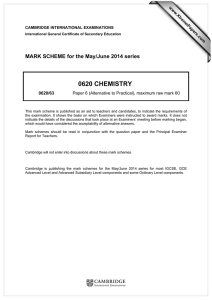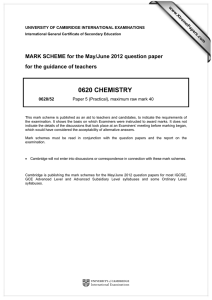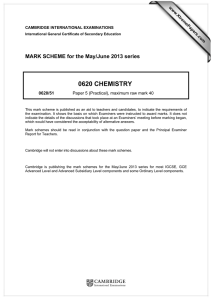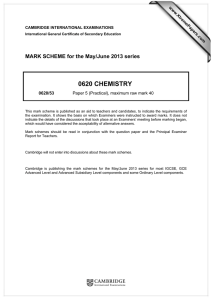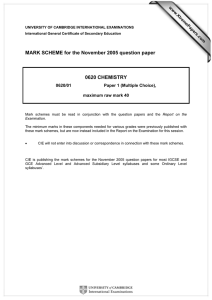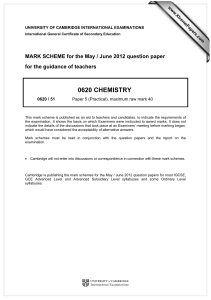0620 CHEMISTRY MARK SCHEME for the October/November 2011 question paper
advertisement
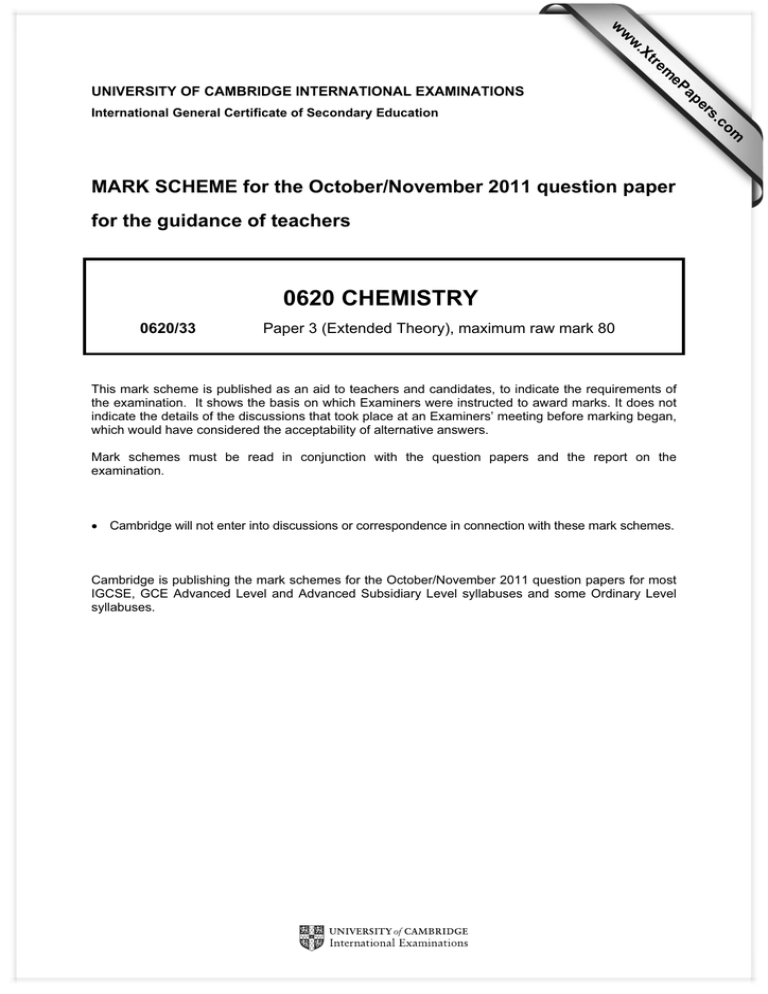
w w ap eP m e tr .X w UNIVERSITY OF CAMBRIDGE INTERNATIONAL EXAMINATIONS for the guidance of teachers 0620 CHEMISTRY 0620/33 Paper 3 (Extended Theory), maximum raw mark 80 This mark scheme is published as an aid to teachers and candidates, to indicate the requirements of the examination. It shows the basis on which Examiners were instructed to award marks. It does not indicate the details of the discussions that took place at an Examiners’ meeting before marking began, which would have considered the acceptability of alternative answers. Mark schemes must be read in conjunction with the question papers and the report on the examination. • Cambridge will not enter into discussions or correspondence in connection with these mark schemes. Cambridge is publishing the mark schemes for the October/November 2011 question papers for most IGCSE, GCE Advanced Level and Advanced Subsidiary Level syllabuses and some Ordinary Level syllabuses. om .c MARK SCHEME for the October/November 2011 question paper s er International General Certificate of Secondary Education Page 2 1 Mark Scheme: Teachers’ version IGCSE – October/November 2011 Syllabus 0620 Paper 33 (a) (i) Cs / Fr [1] (ii) Br [1] (iii) U / Pu / Th [1] (iv) I or At [1] (v) As [1] (vi) He / Ne / Ar / Kr / Xe [1] (b) (i) GeO2 / GeO (ii) TeBr2 / TeBr4 (c) (i) Sr2+ [1] [1] (ii) F– 2 [1] [1] (a) (i) molecule / unit / simple compound / building block and used to make a polymer / big molecule / long chain / macromolecule formation of a polymer / big molecule / long chain / macromolecule or joining of monomers and elimination / removal / formation of a simple or small molecule / H2O / HCl note: two points needed for 1 mark in both parts (ii) -O- linkage three correct monomer units continuation (b) (i) catalyst and from living organism accept: biological catalyst / protein catalyst [1] [1] [1] [1] [1] [1] (ii) enzyme denatured / destroyed [1] (iii) chromatography locating agent / description of locating agent measure Rf / compare with standards [1] [1] [1] © University of Cambridge International Examinations 2011 Page 3 3 Mark Scheme: Teachers’ version IGCSE – October/November 2011 Syllabus 0620 (a) sodium hydroxide solution warm (only) ammonium phosphate gives off ammonia / gas (which will turn red litmus paper blue) or: sodium hydroxide solution dissolve fertiliser in water Ca2+ gives (white) ppt or: flame test Ca2+ brick red / orange / orange-red NH4+ no colour [1] [1] (b) iron catalyst pressure 150–300 atmospheres temperature 370–470 °C N2 + 3H2 ⇌ 2NH3 note: units required for temperature and pressure [1] [1] [1] [1] (c) potassium / K [1] (d) (i) needs to be soluble / in solution (to be absorbed by plants) [1] (ii) base proton acceptor (e) plant growth depends on soil acidity or pH / plants have optimum pH (for growth) add Ca(OH)2 / CaO / CaCO3 / lime / slaked lime / quicklime / limestone 4 Paper 33 (a) (i) alloy / mixture iron and carbon / another metal or element etc. (ii) electron loss [1] [1] [1] [1] [1] [1] [1] [1] [1] [1] [1] [1] [1] [1] (b) electrons move from / lost from Mg to steel / iron [1] [1] (c) (i) 2H+ + 2e → H2 not balanced = 1 [2] © University of Cambridge International Examinations 2011 Page 4 Mark Scheme: Teachers’ version IGCSE – October/November 2011 Syllabus 0620 Paper 33 (ii) sacrificial protection – is a cell cathodic protection – is electrolysis NOT electrical cell or: sacrificial protection – electrons from more reactive metal cathodic protection – electrons from battery etc. or: sacrificial protection – does not need or use power / battery / electricity / electrical cell cathodic protection – does or: sacrificial protection uses up / needs a sacrificial / more reactive metal cathodic protection doesn’t 5 [1] [1] [1] [1] [1] [1] (a) light / UV / sun / sunlight / solar energy starts / initiates / speeds up [1] [1] (b) (i) 0.03 % – 1(%) carbon dioxide accept: less than 1(%) 20 % – 21(%) oxygen [1] (ii) remove carbon dioxide from atmosphere produce oxygen any two from: photosynthesis chlorophyll / chloroplast light / sun / sunlight / UV / photochemical formed carbohydrates / glucose / sugar(s) 6 [1] [1] [1] [1] [1] [2] (c) reaction is photochemical / needs light (light) causes formation of silver / silver ions reduced (on formation of silver) goes black no light still silver(I) bromide / stays white / no reaction [1] [1] [1] [1] (a) any three from: barium more reactive / forms ions more readily barium reacts with (cold) water, nickel does not barium more vigorous with acids nickel compounds coloured, barium compounds white nickel has more than one oxidation state, barium has one nickel / nickel compounds catalysts, barium / barium compounds not catalysts nickel forms complex ions, barium does not [3] (b) (i) forward reaction favoured by low temperatures / reverse reaction favoured by high temperatures / heat exothermic [1] [1] (ii) products / RHS has fewer moles / molecules / smaller volume / ORA [1] [1] (iii) do not react or left behind / left at 60 oC [1] © University of Cambridge International Examinations 2011 Page 5 Mark Scheme: Teachers’ version IGCSE – October/November 2011 Syllabus 0620 (iv) electrolysis cathode (pure) nickel anode impure nickel electrolyte is a soluble nickel salt 7 Paper 33 [1] [1] [1] [1] (a) correct method shown i.e. 126/14 (= 9) or 14x = 126 or x = 9 or (12 × 9) + 18 = 126 C9H18 note: correct formula only = 1 [1] (b) (i) all hydrogen atoms 1bp C—C bond atoms 1bp C=C 2 bp [1] [1] [1] (ii) correct repeat unit continuation [1] [1] (iii) bonds broken H-H +436 (kJ/mol) C=C +610 = +1046 (kJ/mol) bonds formed 2C-H –415 × 2 kJ/mol C-C –346 = –1176 (kJ/mol) –130 kJ/mol / more energy released than absorbed or: bonds broken 3882 (kJ/mol) bonds formed 4012 (kJ/mol) –130 kJ/mol / more energy released than absorbed allow: ecf for final mark as long as the answer is not positive note: units not necessary (c) (i) butan-1-ol or butan-2-ol or butanol [1] [1] [1] [1] [1] [1] [1] [1] (ii) CH3-CH2-CH(Br)-CH2Br C4H8Br2 = 1 note: any other dibromobutane = 0 [2] (iii) HI [1] © University of Cambridge International Examinations 2011
